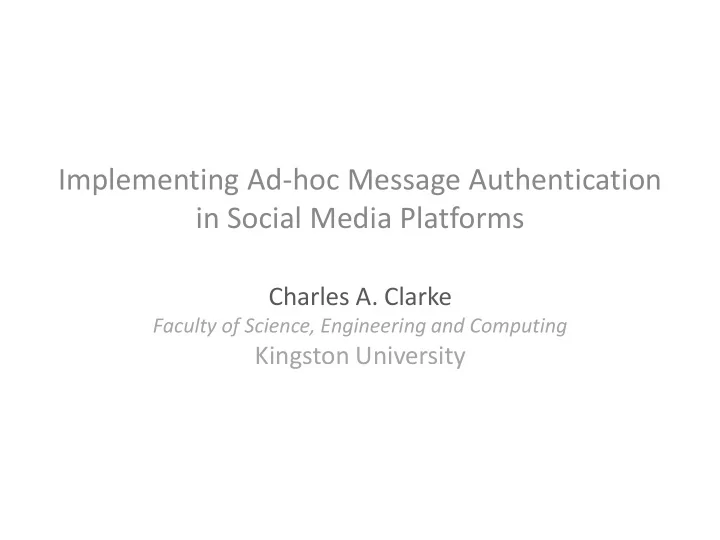

Implementing Ad-hoc Message Authentication in Social Media Platforms Charles A. Clarke Faculty of Science, Engineering and Computing Kingston University
About This Research Research Outline • Domain Social Media Platforms (SMPs) • Problem Addressed Validating the integrity of content shared between SMP users (Message Authentication) • Research Contribution Characterised as a multi-channel overlay authentication protocol
Introduction What are social media platforms (SMPs) and how are they used?
Introduction Social media activity is conducted on a global scale SOURCE: http://wearesocial.net/blog/2015/01/digital-social-mobile-worldwide-2015/sd
Research Problem Routine SMP modifications pose integrity threats to user content • Content Reformatting – E.g. YouTube videos converted during upload • Image cropping, resizing etc – Images are changed to comply with a specific SMP presentation format • Watermarking and metadata changes – Metadata added or changed to for the purposes of identification, ad delivery and tracking etc
Research Problem Why is message authentication important in the context of SMPs? • Message authentication is relevant to scenarios that include the sharing of legal, time stamped, forensic and journalistic content, where statements, images and videos may need to be validated as original (i.e. unaltered and genuine).
Research Problem Some SMPs apply functional constraints • Capacity constraints restrict content size – E.g. Twitter 140 character limit • Format constraints limit types of content – E.g. WhatsApp, Viber, Line allow sharing of text, image, audio and video formats, but not pdf, word, excel etc • Contextual constraints require appropriate content for the environment – E.g. Publishing cipher-text would appear conspicuous
Research Contribution Synopsis Message Authentication • Alice transmits a message m to Bob where m is subject to SMP threats and constraints. • Goal? Find a way for Bob to authenticate m in an ad-hoc manner. SMP m m m SMP ALICE BOB
Research Contribution Related Work – Hash Based Ad-hoc Device Pairing Concept d 0 m k m ’ k d 0 ’ Out-Of-Band Channel (Human Controlled) d 1 d 0 d 0 d 1 d 0 ’ d 1 ’ HASH HASH FUNCTION FUNCTION k d 1 Wireless Channel (Insecure) If d 1 = d 1 ’ , the Verifier has m authenticated the Claimant. Claimant Verifier d 0 digest = H(m) m message k secret key d 1 digest = H(k || d 0 )
Research Contribution Our Approach - Concepts Our approach generally mirrors device pairing, with some notable differences: • Authenticate content and not entities • Multiple untrusted SMP channels…no OOB • No secret key.
Research Contribution Our Approach - Implementation Assumptions • SMP channels are independent and non colluding. • Links between users and SMPs are https secured. • SMPs establish entity authentication • We assume that SMPs may eavesdrop on content and may modify it. • Users trust each other and have appropriate accounts on common SMPs.
Research Contribution Our Approach – Multi-channel Message Authentication Concept m If Bob derives d’ = d’, SMP Channel 0 then m’ is authentic. (e.g. Google+) d d d ’ HASH FUNCTION HASH FUNCTION d ’ m m’ SMP Channel 1 Alice Bob (e.g. WhatsApp) m message d digest = H(m)
Research Contribution Summary of Benefits and Limitations Benefits • Approach is easy and intuitive to implement • Scalable • Can be used as a ‘probe’ to identify SMPs that modify content Limitation • Message authentications (e.g. digests) must be contextually relevant. Can be mitigated by concealing digests using steganography (e.g. jpg dct, text DLSB).
Research Contribution Summary of Implementation Requisites Participants require access to: • Accounts on pre-agreed SMPs • A cryptographic hash function tool • An agreed steganography tool
Conclusions Summary • Approach is characterised as a multi-channel overlay protocol , for ad-hoc authentication of content shared between users in SMPs. • Relevant to scenarios that include the sharing of Legal, time stamped, forensic and journalistic content, where statements, images and videos may need to be validated as original.
References References [1] C. Heller Baird and G. Parasnis, “From social media to social customer relationship management,” Strategy & Leadership, vol. 39, no. 5, pp. 30 – 37, 2011. [2] C. Clarke, E. Pfluegel, and D. Tsaptsinos, “Confidential communication techniques for virtual private social networks,” in Distributed Computing and Applications to Business, Engineering & Science (DCABES), 2013 12 th International Symposium on. IEEE, 2013, pp. 212 – 216. [3] M. Conti, A. Hasani, and B. Crispo, “Virtual private social networks,” in Proceedings of the first ACM conference on Data and application security and privacy. ACM, 2011, pp. 39 – 50. [4] D. P. Maher, “Secure communication method and apparatus,” Sep. 12 1995, uS Patent 5,450,493. [5] F. Stajano, “The resurrecting duckling,” in Security Protocols. Springer, 2000, pp. 183– 194. [6] D. Balfanz, D. K. Smetters, P. Stewart, and H. C. Wong, “Talking to strangers: Authentication in ad -hoc wireless networks.” in NDSS, 2002. [7] C. Gehrmann, C. J. Mitchell, and K. Nyberg, “Manual authentication for wireless devices,” RSA Cryptobytes, vol. 7, no. 1, pp. 29 – 37, 2004. [8] S. Vaudenay, “Secure communications over insecure channels based on short authenticated strings,” in Advances in cryptology – CRYPTO 2005. Springer, 2005, pp. 309 – 326. [9] F.- L. Wong and F. Stajano, “Multi - channel protocols,” in Security Protocols. Springer, 2007, pp. 112 - 127.
Questions
Recommend
More recommend